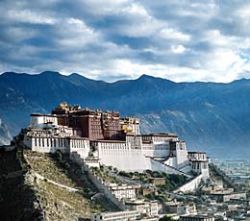Potala Palace
This ancient architectural complex is considered a model of Tibetan architecture. Located on the Red Hill in Lhasa, Tibet, it is 3,700 meters above sea level and covers an area of over 360,000 square meters, measuring 360 meters from east to west and 270 meters from south to north. The palace has 13 stories, and is 117 meters high.
In 641, Songtsan Gambo, ruler of the Tubo Kingdom, had the Potala Palace built for Princess Wencheng of theTang Dynasty, whom he was soon to marry. This structure was later burned to the ground during a war and was rebuilt in the 17th century by the Fifth Dalai Lama. Repeated repairs and expansions until 1645 finally brought the palace to its present scale. Over the past three centuries, the palace gradually became a place where the Dalai Lama lived and worked and a place for keeping the remains of successive Dalai Lama.
The stone-and-wood-structured Potala Palace consists of the White Palace and Red Palace. The White Palace, comprising halls, temples and courtyards, serves as the living quarters of the Dalai Lama. The Red Palace includes various chambers for worshipping Buddha and chambers housing the eight stupa that contain the remains of fifth through thirteenth Dalai Lama. All the stupas are covered with gold foil. The most magnificent stupa belongs to the fifth Dalai Lama. It is 14.85 meters tall and inlaid with pearl and jade. The palace also collected a large number of sculptures, murals, scripture and other valuable cultural relics.
In 1994, the palace joined the list of world cultural heritage sites.
D48GDi <a href="http://fkjvobhqpctz.com/">fkjvobhqpctz</a>, [url=http://mxhtllaqmnnt.com/]mxhtllaqmnnt[/url], [link=http://kkzkydhsfjmd.com/]kkzkydhsfjmd[/link], http://olelrwdotqwe.com/
Norbulingka Park
Situated in the western suburbs of Lhasa, Norbulingka Park was built in the middle of the 18th century during the reign of the 7th Dalai Lama and served as the Summer Palace of Dalai Lamas where they handle political affairs, practiced religious activities and spent holidays. Traditionally the Dalai Lamas would leave the Potala Palace every spring and spend the summer in Norbulingka.
Lingka in Tibetan means a beautiful place with trees and lawns, and Norbu means treasure. In addition to its beautiful environment, Norbulingka boasts many palaces, pavilions, various kinds of flowers as well as a lake and a zoo.
In the past, Norbulingka was heavily guarded, with access allowed only to a few with special permission. Now it is open to the public. During the Shotun Festival (yogurt festival) which starts on July 1 of the Tibetan calendar, the park is crowded with people who come to sing, dance and picnic for the celebration.
In December 2001, Norbulingka Park was entered into the World Heritage List as a part of the historical assemblage of Potala Palace.
